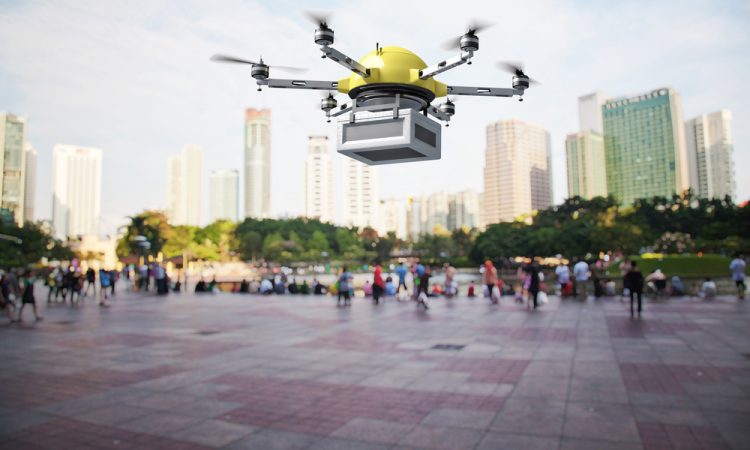An interview by Dawn of Drones with Kevin Morris, Federal Aviation Administration drone specialist and Huy Tran, Director of Aeronautics at the Ames Research Center for National Aeronautics and Space Administration (NASA) outlined the top achievements for UAS and AAM during the past 12 months.
According to media reports, the interview highlighted the following top 3 UAS developments:
Expanded BVLOS Operations
This year, the FAA granted ground-breaking Beyond Visual Line of Sight (BVLOS) exemptions to four companies, Phoenix Air Unmanned, UPS Flight Forward, uAvionix and Zipline.
According to Morris, “These exemptions are paving the way for others to expand BVLOS drone flying.” Other companies can now use these milestone waivers to scale their own complex operations, including for drone deliveries. This interim measure will help move drone logistics forward more rapidly, on a nationwide scale, until the FAA conducts BVLOS rulemaking.
Streamlined Agricultural Drone Operations
This year, the FAA witnessed a surge in applications from UAS operators seeking to incorporate their tech into agricultural operations under part 137. Originally, the agency followed its long-standing process for traditional aviation to grant these approvals for UAS. This led to delays of 9 months to a year to operate UAS for crop-spraying.
After approving hundreds of these requests with minimal incidents, the FAA adopted a risk-based approach to streamline the certification process for lower-risk UAS ag operations. Specifically, the FAA streamlined the Part 137 UAS certification process and transferred responsibilities within the Safety Assurance System (SAS) to the 137 UAS Operations Office
Morris explained the dramatic difference this policy change has made. “If you’re operating a drone under 55 pounds, essentially a part 107 type operation, you can start to get your authorization to operate in as little as 30 days,” he said. “We’ve really made that process much more efficient.”
Like the four BVLOS waivers, leveraging the lessons learned from the expedited part 137 process may set a baseline for potential applications in other complex operations.
Advancements in Air Traffic Management (ATM)
Huy Tran noted that NASA made significant progress relevant to UAS Traffic Management (UTM) this year. Specifically, through NASA’s Advanced Capabilities for Emergency Response Operations (ACERO), the agency’s researchers successfully conducted first-ever tests using a mobile air traffic management kit, in the context of wildland firefighting.
The kit provides a comprehensive view of crewed aircraft locations in the airspace, complementing the vigilance of UAS pilots. Deployed across forests in Tennessee, Mississippi, Georgia, Florida, and South Carolina, this kit enhances awareness for remote ground pilots. NASA’s goal is to commercialize it and make ATM a reality on a smaller scale for public safety agencies.
According to media reports, the interview highlighted the following top 3 UAS developments:
Air Taxi Operations Started to Take Off
In 2023, the FAA released its Urban Air Mobility (UAM) Concept of Operations (ConOps) version 2.0, essentially a blueprint that outlines the future of air taxi operations in the national airspace.
According to the ConOps, initially, air taxis will operate using existing routes and helipads, following the same rules as helicopters. The blueprint envisions designated corridors for air taxis, with pilots on board actively flying the aircraft. As operations increase, the system will likely evolve into two-way traffic corridors using industry-developed technologies for safety separation.
In addition, 2023 witnessed the first flights of air taxis in New York’s complex airspace. Tran highlighted the continued collaboration between the FAA, NASA and industry to make these flights happen and seamlessly integrate these air taxis into the National Airspace System (NAS). The goal is to make air taxis routine, scalable, and affordable, opening avenues for medical transportation and other public-good use cases.
Innovate 28 Plan
In July, the FAA released the Innovate 28 plan, a roadmap for routine AAM operations by 2028. The plan emphasizes massive coordination between the FAA, NASA, local governments and industry stakeholders. It addresses key aspects such as vertiports, electrical grid support and airworthiness criteria for UAS and electric vertical takeoff and landing (eVTOL) aircraft.
Morris added. “We called it Innovate28 because the idea is that by 2028, we are going to have routine AAM operations. They may not be at scale in ‘28, but the goal is to have those routine operations operating by 2028.” These flights are projected to coincide with the L.A. Olympic games that same year.
UTM Field Tests
Tran noted that NASA has selected a key site for real-world UAS Traffic Management (UTM) trials. This will pick up on the research NASA had formally completed in 2019 in Nevada.
The UTM Key Site Operational Evaluation forges strategic partnerships with operators and UAS Service Suppliers (USSs). Through collaborative efforts, participants seek necessary exemptions to operate BVLOS at a designated key site utilizing UTM services. The FAA envisions that this operational evaluation will not only facilitate ongoing operations at the key site but will also serve as a dynamic “living lab.” Tran said: “We are calling this a living lab because once we set up the infrastructure, then industry, academics and other government agencies can continue to use it as a way to improve the technology and to test it out before it goes into operations,” she said.
The goal is that every year, NASA will demonstrate technical UTM capabilities to assist the FAA in allowing full-scale UAS operations.
Next steps
Morris spoke about the FAA’s planned evolution of airworthiness criteria for UAS. “We’re going to get into more of the airworthiness criteria for drones, moving away perhaps from Special Airworthiness Certificates into full-fledged airworthiness certificates,” he said. “This will be the next big step toward routine scalable operation.”
Listen to the Dawn of Drone podcast here
(Image: Shutterstock)
For more information visit:




